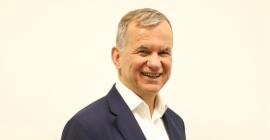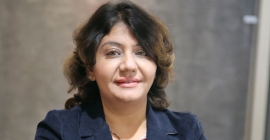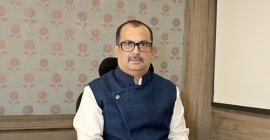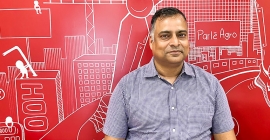‘OOH is the soul of advertising’
By Pray Jani - February 03, 2020
Rakesh Sharma, Dy General Manager – Marketing, Bank of Baroda talks about the banking major’s approach to OOH advertising
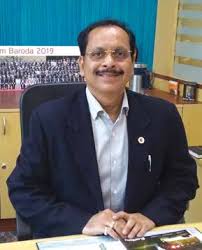 What role does OOH play in your marketing mix?
What role does OOH play in your marketing mix?
OOH is very prominent in the BFSI (Banking, Financial Services and Investment) segment. To show your presence, you have to leverage outdoor media and online presence can never make that impact. A message that is seen in the outdoor will always be instilled in the minds of the consumers. Now electronic media is also coming into the picture that grabs more attention. And when consumers get exposed to the outdoor campaign repeatedly, their inner sense will tell them to go to the bank and see what they have to offer. Hence, to keep your brand in a hygienic position and to get returns on investment, it is very important for a brand to be available in the outdoor advertising space. If I have to explain through an allegory, OOH is the soul of advertising.
What are the key cities that you target for your OOH campaigns?
According to our planning, we cover majority of the cities. However, depending on our product, we essentially target A-class and B-class cities in India. For these cities, if we are advertising in transit media options, around residential areas, where working population is in large proportion, we have a variety of products to offer to them. Bank of Baroda also has offerings for C-class cities. To promote our rural-based products for rural and agricultural development, we also target C-class cities. Coming back to A-class cities, we essentially target large corporates, business houses and other such economic zones.
What formats, according to you, perform best for your OOH campaigns?
I believe, presence on hoardings at key locations in any city is a must during an OOH campaign. Alongside this, there are many innovative options available in malls and cinema. Moreover, a large population of TG is found in malls as well, and for that reason, mall advertising is also a key part of an OOH campaign. With that said, one must a maintain a hygienic presence in the malls. By hygienic, what I mean is, when my brand’s colour palate, the meaning that I give through my creative, the brand’s philosophy, all of these factors must sync together and be maintained in every campaign. We make sure that the vermilion of our logo is always of the same shade wherever it is used. More than just a location, it is important for a brand to keep regulating their creatives so the consumers can get the idea that it is a happening organisation. Having one creative run for six months or a year will not fetch great returns as having creatives regulated will.
What parameters do you look into when planning a campaign and designing the creative?
We look into the facts about which product is being advertised, and which city is being targeted. We have a mix of various advertising medium, where OOH is a must. We believe that the creative should explain the strength of the product, and the product should speak for the brand. Placing only the brand’s logo does not work, at least in our BFSI segment. Hence, to answer this question, the parameters being considered are, the product that we want to advertise about and the city that we are advertising in. That will help us define the advertising medium we have to pick, whether it is radio jingles or print format. However, OOH is always a part of the campaign in any city. This is because an OOH campaign, when executed correctly, will be visible to every section of the city. As against a radio jingle that lasts barely 12 -15 seconds, to a television ad, which is visible only for 30 seconds at a time, an OOH campaign near a junction is visible throughout the day, which generates high frequency. Moreover, it allows the recipient to image the product while stationed at the junction. It is simply unmissable. It is true what they say that successful people do things differently and that is what we try to incorporate in our campaigns. If you look at our site at the Amritsar airport, you will see that it stands out from other formats. That is exactly the kind of uniqueness we want our OOH campaigns to project
As a frequent advertiser on the OOH media, how do you see the industry evolving?
If we see the last decade, it has grown many folds, with newer formats coming up and opening more opportunities for outdoor. Earlier, OOH focused only on pamphlets, leaflets, and static media like hoardings, gantries and pole kiosks. Today we see a different culture. Demographically, the working population comprises 25-40 year olds and a vast majority of this segment are tech savvy, which has resulted in evolution in technology. For this reason, OOH consumers do not want to see what we want to show, and now brands will have to think innovatively and show the consumers what they want to see.
Digital OOH media is the new age of OOH, which is shifting the trend from pasting static creatives on large hoardings to neon boards, LED mesh, digital screens and so on. Media has changed entirely in the last decade and this change has made outdoor advertising more beautiful. Some media are such that it will tempt the consumers to wait there and behold the site.
Another mentality that the brands follow is that they require a lit hoarding. This is because, when a hoarding is non-lit, it creates negative publicity during the evening. Earlier, brands did not consider this aspect so strongly. Now, the expectations of the audience have grown from the OOH campaigns and as a brand, one should meet those expectations.
Do you believe that integrating an OOH campaign with multiple formats drives bigger impact?
Being in the BFSI segment, our target is to capture maximum audience, and we plan our campaign accordingly. In my understanding, malls are highly active zones where advertising can happen. People visit malls not only to purchase but rather, they have turned into leisure spots, especially during the weekends. Be it for movies, or enjoying some fast food, people are going to malls for several reasons today, and as a brand, we should be present in the malls. Recently, DLF Cyber Hub came up in Gurugram, and we made it a point to show our presence there. We are present on transit media formats as well, with Delhi metro wraps, airport media, both inside and outside. We also take traditional formats to showcase our product across cities like Delhi, Mumbai, Hyderabad, Coimbatore, Amritsar and so on. Bank of Baroda has multiple products and our campaigns need to position them at the right place. Leveraging multiple formats help us in doing so.
Have you leveraged DOOH media so far?
All our media in DLF Cyber Hub are digital OOH and we have been taking digital OOH media for many campaigns that we run. OOH has helped increase the users of our online banking platform. It is upcoming and offers unique campaign options.
What changes do you expect to see in the OOH industry in the coming years?
In the coming years, there will be fierce competition among media owners and solution providers to come up with innovative media for the market. Traditional methods of campaigning will not work and media owners and agencies will have to go out of their way for a unique campaign. Only the ideas that get accepted and executed will survive this race. Today, consumers are not ready to accept traditional media. Their minds are so fertile, and quick, they need innovative means and periodic changes in the way OOH is being conducted. And this need for change has been coming for quite some time. We changed our logo in 2005, and it was a historic decision taken by a PSU, and it was taken after a lot of market study and research. We have dared to act upon our data and it has worked wonders for us. Similarly, in OOH, a lot of campaigns will be backed by research and study, both from the brand’s end as well as the media owners’ end.
How do you monitor your OOH campaign?
We monitor our OOH campaigns very closely. Bank of Baroda has 128 administrative offices in the country and the marketing officer in each office has to upload a picture of a BOB campaign in outdoor at least once a month on our online application for auditing. Then the central team will look at it and examine if it falls in line with our requirements. If there are any changes to be made, they are made immediately.
What are your plans for the coming year?
Today, Bank of Baroda stands at the 23rd position in the list of top 50 companies in India. We want to achieve single digit number here and come in the top 9. We also want our brand to reach a higher number of audiences

Stay on top of OOH media trends

